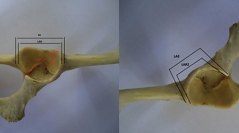

 Comptes Rendus Palevol
13 (7) - Pages 561-567
Comptes Rendus Palevol
13 (7) - Pages 561-567Despite its potential importance in the reconstruction of hunting strategies and subsistence patterns, determining sex in zooarchaeological assemblages is a task that has been often neglected because the assemblages consist mainly of fragmentary bones. Only a limited amount of research has been focused on sexing individuals at archaeological sites. Although dimorphic elements in skeletal anatomy (e.g., horns) are the most widely used indicators for sexing, other skeletal parts, such as the pelvic acetabulum provide valuable information to identify sex. The present work builds upon previous research and indicates the most useful indicators in the pelvic acetabulum to distinguish sex in bovids, with the goal of providing an analytical basis to expand interpretations of carcass acquisition strategies by humans.
Measurement, Hunting, Medial wall, Acetabulum, Subsistence patterns